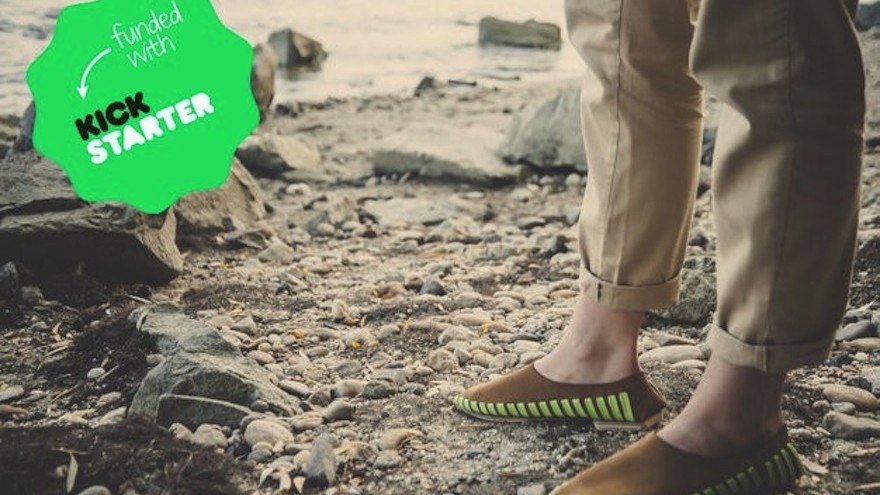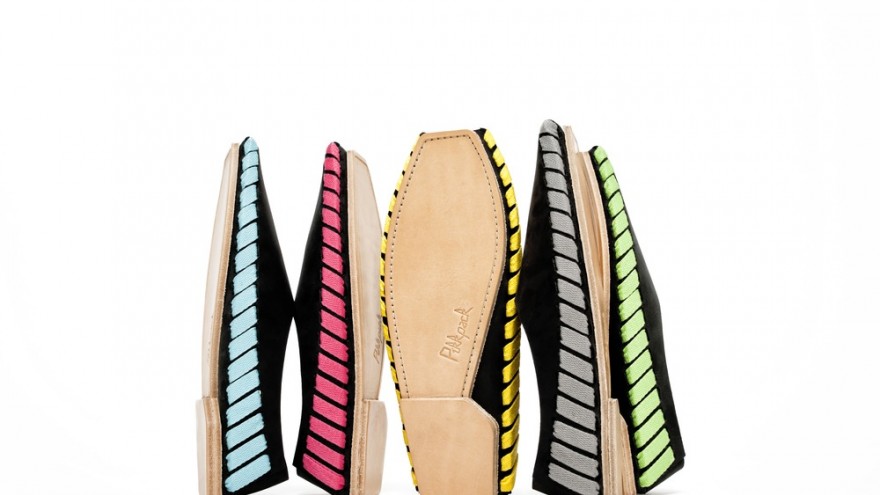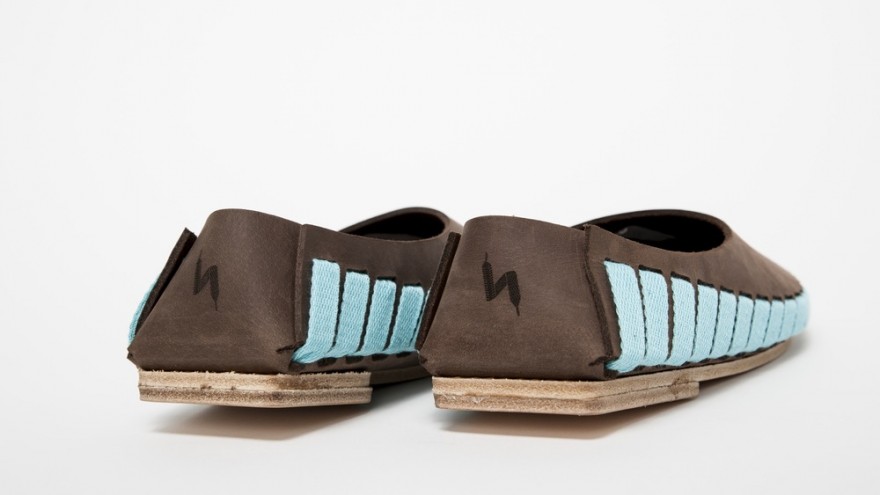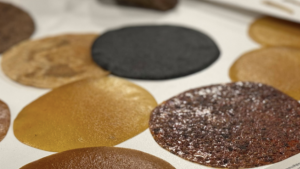Sara Gulyas, a Hungarian designer with over 10 years' experience in leather design, knows a thing or two about launching a successful Kickstarter campaign.
Pikkpack, her simple yet striking flatpack shoe, started out as her diploma project during her master's studies at Moholy-Nagy University of Art and Design. She challenged herself to design a shoe that minimised the amount of material needed and that would encourage people to participate in the shoe-making process.
Inspired by an old Hungarian shoe called Bocskor (pronounced ‘BOTCH-core’) that was traditionally made from one piece of leather, Gulyas designed a shoe that consists of leather uppers attached to a sole, that the user assembles with laces.
On summer vacation in San Francisco, she wore the pair of Pikkpack shoes while exploring the city and stranger after stranger stopped her to ask where she had gotten her shoes from. Struck by the response, she decided to produce the shoes and share them with the world.
She turned to Kickstarter crowdfunding platform to raise the $17 000 she needed for her start-up costs and ended up overshooting her goal by more than $3 000. Here she tells us how to make the most of Kickstarter.
Ten important ingredients for a successful Kickstarter:
- Start the research very early (preferably at least eight months before your launch), find your competitors and learn from them.
- Start building up your communication channels, your website and your social media channels and begin to recruit followers at least six months before the campaign.
- Plan the logistics of your production far ahead and find all your suppliers and partners before the launch.
- Find key thinkers and opinion shapers in your industry and start following them and sending emails to them even before the launch. Always choose a relevant and super catchy subject title.
- Find people who will support you and become your backers in the first days of your campaign. A good start and powerful launch with many early backers will give your campaign a big kick.
- Shoot a top campaign video. Kickstarter argues that there is a 66% higher chance of being funded statistically in projects that have a video. The video should be about letting people get to know you, explaining your idea briefly and making the viewers interested.
- Do not forget to pay attention to your campaign’s consistency. Try to be straightforward, transparent and come up with pledges that fit your product. It’s important that you choose the right pledges and not too many.
- Participate in meetups and competitions to broaden your network and introduce yourself in person, too.
- React to the feedback and try to learn from all the comments and publications your product gets! Pay attention to how your brand is described, what kind of terminology is used and which pictures of your product journalists love to feature.
- Try to generate interesting content each day on social media and always inform your backers during the campaign! Make the process visible, transparent and share your adventures with your followers!
After this brief summary, let us explain some things in more detail. We also strongly advise you to delve into the Kickstarter Handbook at the outset of your preparation.
First of all, you need a good story.
Storytelling is a crucial element of good marketing communication. We had one about the shoes’ success in San Francisco but we needed to put it into the right words and decide how we would share it with more people.
In our case, the preparation started with meticulous competition research on how others had run successful campaigns. We tried to find similar products and searched for the common features of the funded campaigns in the footwear category.
Then start planning the logistics.
It’s tricky because you don’t know if your campaign will succeed or not but you have to make an agreement with all your suppliers and partners in advance because you will need to calculate the cost of the production in order to set your target and your product’s price.
Focus on the campaign and the communication.
When we got all the administration and logistical planning done we began to focus on the campaign and the communication. You surely need a website and social media channels where you can start building up a base of followers. We used our social media network as much as we could to promote the campaign and even made viral videos about different pets playing with the shoelaces.
Regarding the webpage, we worked with a free Squarespace template and managed to construct a nice layout using zero budget. You’d better start building a follower base and engage with key bloggers at least six months before the launch. We collected an extensive PR-media-blogger list before the Kickstarter with approximately 700 to 800 names, contact addresses, hashtags of followers on Facebook and Twitter.
In order to further define our target market and to see what kind of audience reacts to our concept, we addressed five main types of media:
Design and fashion blogs (i.e. Designboom, Design Milk, Ecouterre, Vogue)
DIY blogs (i.e. Honestly WTF, High on DIY, Stripes and Sequins)
Cyclist blogs (i.e. Cycle Love, Urbanvelo, Momentummag)
Crowdfunding blogs (i.e. Kickstarterforum, Ayudos, Crowdfundinsider)
Big media publishers (i.e. Fast Company, Buzzfeed, The Huffington Post, The Guardian)
Contact key bloggers directly.
We started contacting key bloggers directly, approximately one month before the launch and kept on writing to them until the last day of the Kickstarter. Keep in mind: PR activity and reaching out to bloggers is not easy. I sent at least 20 or 30 emails per day and had maybe one publication after every 30 emails. The effect of a publication, even in big media, lasts for about three days. People move on, they forget about you so you have to continue sending emails and follow-ups. Most of the journalists don’t even open your email if your subject line is not catchy enough. Do not try to explain every aspect of your product. Use little text with many links in your email and attach three to four high-resolution photos plus a well-crafted press release.
We drafted five main types of pitch document for the five types of blogs/sites and tried to keep it a bit personal and specific in aech case. We highlighted the aspect of the project we thought they would be interested in. Many times we referenced old posts and articles of theirs, which was very effective. In our case, the big sites such as Fast Company, PSFK, Wired and Gizmag generated many backers. Another very important thing was to learn from the publications. After noticing that more and more journalist compared us with IKEA (i.e. FastCompany called Pikkpack "the IKEA of shoes”), we picked this terminology up and began to use it in our press releases.
Don’t panic if you experience very low traffic and lack of interest in the middle of your campaign. It’s quite typical.
People engage with things when they are new or when they are nearing the end. They lose interest in the middle period. The biggest blogs will also notice you only after it’s predictable that your campaign will be fully funded. Everyone loves to support successful things. You have to come up with strong marketing tricks in this period and if you get over it somehow, your financial success will accelerate. It can be a huge push if you get into the Kickstarter staff pick selection. When we nearly reached our target, we noticed that Pikkpack was listed among this selection. It lasted for a very short time but gave us six backers in one hour (compared to the usual six-backers-per-day average).
This article was first published on Pikkpack's blog.









